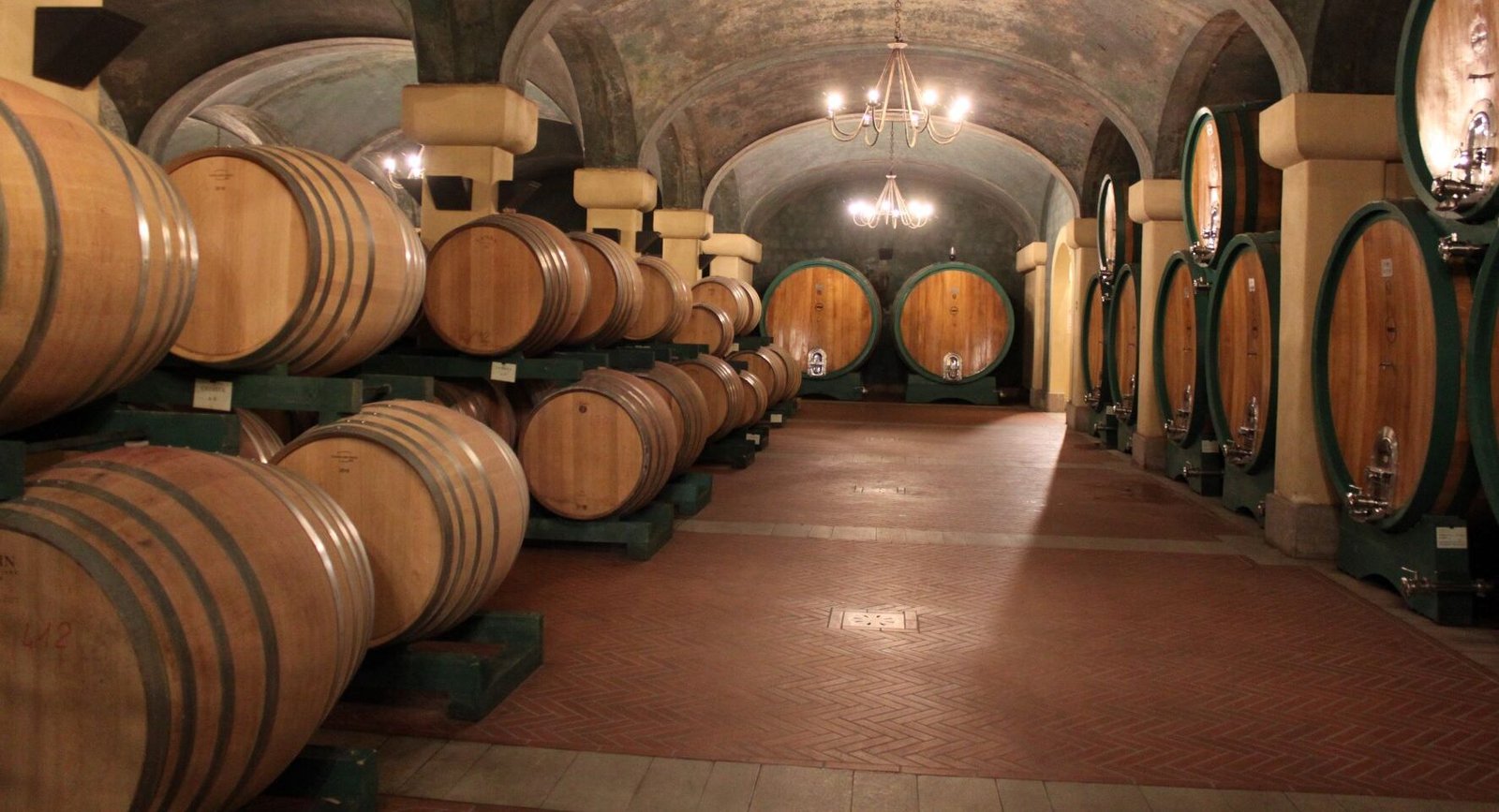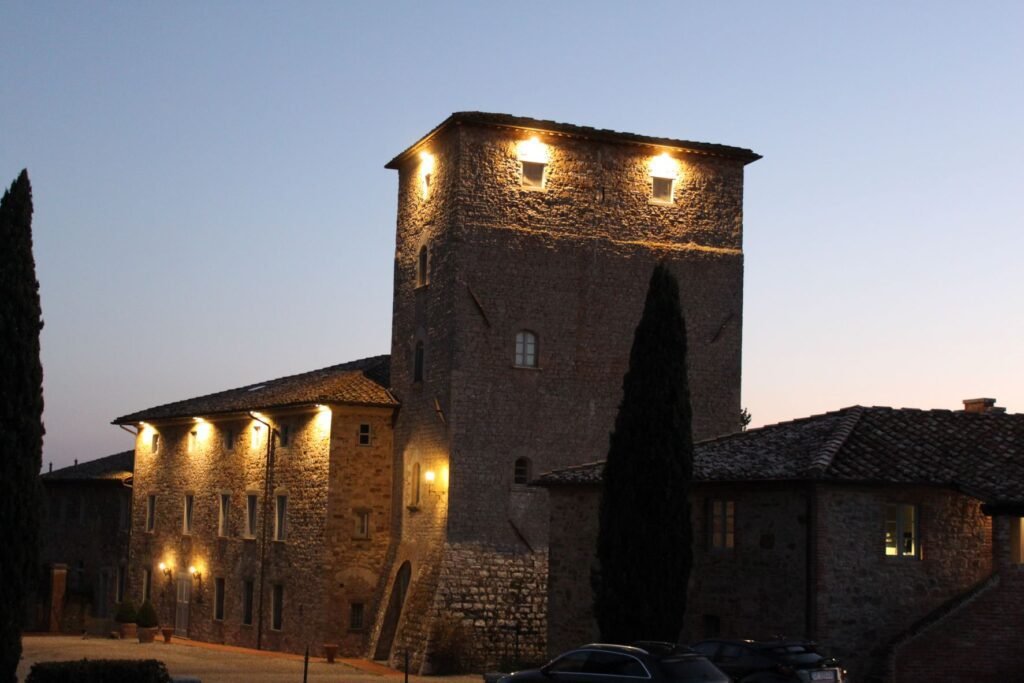It was about four o’clock in the afternoon when we parked in front of the Cantina di Scopeto. We were in the Chianti region, specifically in Chianti Classico: 70,000 hectares between Siena and Florence celebrated throughout the world for the gentle slope of its hills, its green countryside and, naturally, its wine. It was precisely wine that was the guiding light of our journey to discover Elisabetta Gnudi Angelini’s wineries.

We arrived in Scopeto, in the Sienese municipality of Castelnuovo Berardenga. We did not even have time to exit our car before a young woman came out to welcome us and introduce us to the estate.
The kindness and elegance of the Cantina di Scopeto is fully embraced by this magnificent territory. On the other hand, the town has been here since 1079, when it was just a hamlet, which in its most thriving years, as Alessandra Angelini would later recount to us, housed over 500 people. As a matter of fact, it was around the year 1300 that the estate, formerly a military outpost, was donated to the Sozzini family, who transformed it into a residence, around which small shops and dwellings burgeoned.
Instead, it was in 1997 that this magical location underwent its last major transformation. Through the efforts of Elisabetta Gnudi Angelini who, having purchased the estate, immediately comprehended its potential, as she endeavoured to develop its promise and strengthen its production without, however altering its fundamental character.


Our visit began in the grape harvest area, in the vicinity of the vineyards. From this area, the wine is transferred to the cellars using the gentle and natural force of gravity. There, underground, where the temperature and humidity are naturally constant the wine will be allowed to rest, still and peaceful.
As our visit continued, we discovered that this conjunction of nature and technology is one of the stylistic features of how Elisabetta has decided to work. Rather than intervening with chemistry downstream her preference for technological interventions upstream maintains the natural goodness of her products at the highest levels.
Though the winery is currently able to produce about 300,000 bottles per year, this is certainly not the Scopeto Estate’s only form of production. Having just finished tasting the estate’s products – several wines, and also excellent oil – Alessandra Angelini, Elisabetta’s daughter and trusted assistant, arrived and bid us to quickly follow her towards Borgo Scopeto since it would soon to be dark, which would not allow us to fully experience the magical beauty of these locations.

So, we got back into our car and after Alessandra quickly and safely drove a few kilometres down a dirt road, whilst we followed along a bit more slowly, we came upon the heart of the ancient settlement of Borgo Scopeto. The visual impact was truly breathtaking.
The estate faces Siena, seven kilometres away as the crow flies, with the city’s towers clearly standing out right before our eyes, kept watch over by a Marzocco topping a column towering over the middle of a meadow, which, as Alessandra explained, is a 16th century installation by the Florentines ‘who placed the symbolic lion to guard over Siena’.
Today, the ancient hamlet is a magnificent Relais, which, once again in full Angelini style, has been brought back to life thanks to skilful conservative restoration. By using local materials, the refurbishment of the old buildings has resulted in the construction of a very modern complex, characterized by exceptional services, whilst at the same time exuding an ancient and majestic flavour. The Relais comprises 52 accommodation units, housing a total of 132 beds.
There are two swimming pools, two tennis courts, fields planted in lavender and helichrysum plants, and a restaurant that can seat up to 150 diners. In addition, the Relais has a series of features aimed at valorising business clientele, including several conference rooms, with one that can accommodate over 150 participants.
This feature, which is more unique than rare in this area, led to the estate being chosen for the launch of the Ferrari California – the only launch that the Prancing Horse brand decided to carry out outside of Maranello – and the Aston Martin DB9.
If the presence of services that allow corporate meetings and presentations are a rare feature for Relais of this type, after a quick tour of the interiors – with the tasting room, located inside an ancient cistern for collecting water, being at least worth mentioning – Alessandra proudly showed us the estate’s Roccolo, one of only two remaining in all of Tuscany. This was an ancient hexagonal garden, rich in plants with medium-sized trunks, which the nobles once covered with mesh to then use the structure for hunting birds and trapping the smallest with nets.
The Roccolo feels something like a labyrinth, with the plants so dense that, depending on the time of day, makes it practically dark inside. Though it is difficult to notice while inside, seen from above, the garden looks like a six-pointed cross, a sort of large asterisk made of plants.
It was full dark when, having completed our visit, we went from Borgo Scopeto to the Altesino Estate, in Montalcino. It was here that we spent the night, waiting to visit the two estate wineries – Altesino and Caparzo – dedicated to the production of what is perhaps the world’s most iconic red wine.
The flat where we stayed, which was spacious and functional, whilst retaining all the charm of an old Tuscan home, was one of the accommodations on the Altesino estate.
Early in the morning on the next day, the always kind and highly knowledgeable staff accompanied us to Caparzo, the other Angelini family estate, where it was suggested we start our visit, so we could then return to Altesino, where we were to meet up with Elisabetta Gnudi Angelini. Every member of the staff we met seemed extremely proud of their work, by exuding a great level of satisfaction.
Often, they would mention Mrs Gnudi Angelini, who despite the multiplicity and size of the activities she had to manage, they explained to us, was always extremely attentive and present whilst at the estate, and willing to immediately respond to and resolve even the least significant issue.
Caparzo is one of the historical Brunello di Montalcino estates. When we asked what was meant by ‘historic Brunello estates’, they explained that although these lands have naturally always produced wine, it was only in the 19th century that the progenitor of the famous Brunello began to be produced.
Then, in the 1960s a small group of estates created the regulations that authorised the definitive transformation of Brunello di Montalcino into the wine we know today Caparzo was one of those estates. It all began with a group of professionals and friends from Milan who, at that time, bought the estate to transform it into their summer residence. It was not until 1998 that Elisabetta Gnudi Angelini, after buying Borgo Scopeto – even though her first objective, she would later reveal, had always been Caparzo! – she was also able to acquire the Caparzo Estate.
Once again, Mrs Gnudi Angelini immediately understood the estate’s potential – not to mention Brunello’s! Therefore, she implemented a skilful expansion of the historic cellars. Not only that. She was among the first owners to equip all her facilities, including Borgo Scopeto – with clean energy production systems. The focus on eco-sustainability was evident, having its roots in the winery’s early days, well before the green economy became a real trend.
After a tour of the beautiful cellars, characterised by the same green that can be found on the labels, and a viewing of the gallery of portraits, one for each year, that depict workers of the estate, it is time for the tasting. We were a little timid since it was just 10:30 in the morning. Nevertheless, after our first sip any worry we might have had was swept away by the flavours released from the estate’s wines: simply exceptional. The oenologist who guided us on our journey through the estate’s products explained that Caparzo’s Brunello di Montalcino wines are the product of years and years of careful selection and hard work.

In fact, the area where Brunello is produced is extremely restricted. There are just a handful of hills. This means that small climatic variations – a rainier year on a certain slope, or a particularly windy summer on another – can bring big changes in the production of the wines, strongly altering their character and sometimes ruining entire vintages. Over the years, to cope with this situation, the estate has expanded by purchasing several vineyards on different slopes.
Today there are eight of them, perfectly distributed so that, regardless of changing seasonal weather conditions, a good degree of uniformity can be ensured for the million bottles that leave the Caparzo winery each year to arrive on tables all round the world.
It was nearly lunchtime when we returned to the Altesino estate to finally meet Elisabetta Gnudi Angelini, who proved to be an elegant and jovial woman who, after welcoming us with a charming smile, told us her story, which began in Rome at the palaces housing the Confagricoltura or the General Confederation of Italian Agriculture.
It was there that Elisabetta worked as a proofreader, after being widowed with two small children following the death of her husband in an auto accident. And it was doing this job that, after getting to know the world of cultivation, agriculture and hence also wine growing, she decided to leave the capital in for the Tuscan countryside.
Elisabetta was 40 years old. Therefore, she approached the world of wine from a range of different experiences. She had worked in hotel management in the United States and at the family pharmaceutical company.
However, her entrepreneurial intuition led her to immediately understand the potential of Chianti wine and especially the Montalcino area. Thus, her adventure in the world of wine began: an adventure whose last stage was the acquisition of the estate where we were at that moment, Altesino. Again, this is also a historical place. Bordering on the Caparzo estate, the main building, which today houses her private residence, dates back to 1414.
When the previous owner decided to sell, the French owners of Chateau Margot had expressed an interest. “They are people who make wonderful wine”, Elisabetta explained, “but whom I preferred to not have as my neighbours. No doubt, they would have tried to give us advice on how to make wine! And then often, these big groups buy up the estates but do not work on them directly. Instead, in Italy, wine is a family affair. All the big families that produce historic wines, such as Antinori, or Frescobaldi, are still there.
They are present. They care. I am like that too”. At that point, after discussing the history of these places, we could not wait to ask Elisabetta something about the future of her estates. Her answer was perfectly consistent with what she had just recounted: “I am thinking about stopping. I hope to slowly pass the baton on to my daughter, who has returned to work in the family business, after having been employed as an aerospace engineer in the United States. Actually, though, we just bought a new vineyard a few days ago, so I don’t really know if I will have time to stop!”

